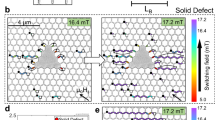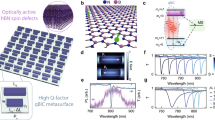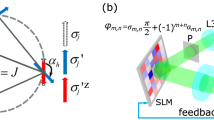Abstract
Spin models arise in the microscopic description of magnetic materials and have been recently used to map certain classes of optimization problems involving large degrees of freedom. In this regard, various optical implementations of such Hamiltonians have been demonstrated to quickly converge to the global minimum in the energy landscape. Yet, so far, an integrated nanophotonic platform capable of emulating complex magnetic materials is still missing. Here, we show that the cooperative interplay among vectorial electromagnetic modes in coupled metallic nanolasers can be utilized to implement certain types of spin Hamiltonians. Depending on the topology/geometry of the arrays, these structures can be governed by a classical XY Hamiltonian that exhibits ferromagnetic and antiferromagnetic couplings, as well as geometrical frustration. Our results pave the way towards a scalable nanophotonic platform to study spin exchange interactions and could address a variety of optimization problems.
This is a preview of subscription content, access via your institution
Access options
Access Nature and 54 other Nature Portfolio journals
Get Nature+, our best-value online-access subscription
$29.99 / 30 days
cancel any time
Subscribe to this journal
Receive 12 print issues and online access
$259.00 per year
only $21.58 per issue
Buy this article
- Purchase on Springer Link
- Instant access to full article PDF
Prices may be subject to local taxes which are calculated during checkout






Similar content being viewed by others
Code availability
The codes associated with this manuscript are available from the corresponding author on reasonable request.
References
Van Vleck, J. H. The Theory of Electric and Magnetic Susceptibilities (Clarendon, 1932).
Wolf, S. A. et al. Spintronics: a spin-based electronics vision for the future. Science 294, 1488–1495 (2001).
Johnson, M. W. et al. Quantum annealing with manufactured spins. Nature 473, 194–198 (2011).
Sadoc, J.-F. & Mosseri, R. Geometrical Frustration (Cambridge Univ. Press, 1999).
Pauling, L. The structure and entropy of ice and of other crystals with some randomness of atomic arrangement. J. Am. Chem. Soc. 57, 2680–2684 (1935).
Ramirez, A. P., Hayashi, A., Cava, R. J., Siddharthan, R. & Shastry, B. S. Zero-point entropy in ‘spin ice’. Nature 399, 333–335 (1999).
Harris, M. J., Bramwell, S. T., McMorrow, D. F., Zeiske, T. & Godfrey, K. W. Geometrical frustration in the ferromagnetic pyrochlore Ho2Ti2O7. Phys. Rev. Lett. 79, 2554–2557 (1997).
Wu, C. Orbital ordering and frustration of p-band mott insulators. Phys. Rev. Lett. 100, 200406 (2008).
Wright, D. C. & Mermin, N. D. Crystalline liquids: the blue phases. Rev. Mod. Phys. 61, 385–432 (1989).
Balents, L. Spin liquids in frustrated magnets. Nature 464, 199–208 (2010).
De las Cuevas, G. & Cubitt, T. S. Simple universal models capture all classical spin physics. Science 351, 1180–1183 (2016).
Kirkpatrick, S., Gelatt, C. D. & Vecchi, M. P. Optimization by simulated annealing. Science 220, 671–680 (1983).
Bloch, I., Dalibard, J. & Nascimbène, S. Quantum simulations with ultracold quantum gases. Nat. Phys. 8, 267–276 (2012).
Struck, J. et al. Quantum simulation of frustrated classical magnetism in triangular optical lattices. Science 333, 996–999 (2011).
Trotzky, S. et al. Time-resolved observation and control of superexchange interactions with ultracold atoms in optical lattices. Science 319, 295–299 (2008).
Struck, J. et al. Engineering Ising–XY spin models in a triangular lattice using tunable artificial gauge fields. Nat. Phys. 9, 738–743 (2013).
Marandi, A., Wang, Z., Takata, K., Byer, R. L. & Yamamoto, Y. Network of time-multiplexed optical parametric oscillators as a coherent Ising machine. Nat. Photon. 8, 937–942 (2014).
McMahon, P. L. et al. A fully programmable 100-spin coherent Ising machine with all-to-all connections. Science 354, 614–617 (2016).
Takeda, Y. et al. Boltzmann sampling for an XY model using a non-degenerate optical parametric oscillator network. Quantum Sci. Technol. 3, 014004 (2018).
Berloff, N. G. et al. Realizing the classical XY Hamiltonian in polariton simulators. Nat. Mater. 16, 1120–1126 (2017).
Lagoudakis, P. G. & Berloff, N. G. A polariton graph simulator. New J. Phys. 19, 125008 (2017).
Nixon, M., Ronen, E., Friesem, A. A. & Davidson, N. Observing geometric frustration with thousands of coupled lasers. Phys. Rev. Lett. 110, 184102 (2013).
Pal, V., Tradonsky, C., Chriki, R., Friesem, A. A. & Davidson, N. Observing dissipative topological defects with coupled lasers. Phys. Rev. Lett. 119, 013902 (2017).
Hill, M. T. et al. Lasing in metallic-coated nanocavities. Nat. Photon. 1, 589–594 (2007).
Noginov, M. A. et al. Demonstration of a spaser-based nanolaser. Nature 460, 1110–1112 (2009).
Oulton, R. F. et al. Plasmon lasers at deep subwavelength scale. Nature 461, 629–632 (2009).
Khajavikhan, M. et al. Thresholdless nanoscale coaxial lasers. Nature 482, 204–207 (2012).
Khomskii, D. I. Transition Metal Compounds (Cambridge Univ. Press, 2014).
Feng, J. S. & Xiang, H. J. Anisotropic symmetric exchange as a new mechanism for multiferroicity. Phys. Rev. B 93, 174416 (2016).
Vleck, J. H. V. Recent developments in the theory of antiferromagnetism. J. Phys. Radium 12, 262–274 (1951).
Strogatz, S. H. Exploring complex networks. Nature 410, 268–276 (2001).
Ariaratnam, J. T. & Strogatz, S. H. Phase diagram for the winfree model of coupled nonlinear oscillators. Phys. Rev. Lett. 86, 4278–4281 (2001).
Soriano, M. C., García-Ojalvo, J., Mirasso, C. R. & Fischer, I. Complex photonics: dynamics and applications of delay-coupled semiconductors lasers. Rev. Mod. Phys. 85, 421–470 (2013).
Ramos, A., Kottos, T. & Shapiro, B. Optical phase transitions in photonic networks: a spin system formulation. Preprint at https://arxiv.org/abs/1912.10569 (2019).
Hickmann, J. M., Fonseca, E. J. S., Soares, W. C. & Chávez-Cerda, S. Unveiling a truncated optical lattice associated with a triangular aperture using light’s orbital angular momentum. Phys. Rev. Lett. 105, 053904 (2010).
Inagaki, T. et al. Large-scale Ising spin network based on degenerate optical parametric oscillators. Nat. Photon. 10, 415–419 (2016).
Moessner, R. & Chalker, J. T. Low-temperature properties of classical geometrically frustrated antiferromagnets. Phys. Rev. B 58, 12049–12062 (1998).
Zhitomirsky, M. E. Octupolar ordering of classical kagome antiferromagnets in two and three dimensions. Phys. Rev. B 78, 094423 (2008).
Parto, M., Hayenga, W., Marandi, A., Christodoulides, D. N. & Khajavikhan, M. Realizing spin Hamiltonians in nanoscale active photonic lattices. Figshare https://doi.org/10.6084/m9.figshare.11796171 (2020).
Parto, M., Hayenga, W., Marandi, A., Christodoulides, D. N. & Khajavikhan, M. Realizing spin Hamiltonians in nanoscale active photonic lattices. Figshare https://doi.org/10.6084/m9.figshare.11796168 (2020).
Acknowledgements
We gratefully acknowledge the financial support from DARPA (D18AP00058, HR00111820042, HR00111820038), Army Research Office (ARO; W911NF-16-1-0013, W911NF-17-1-0481, W911NF-18-1-0285), National Science Foundation (ECCS 1454531, DMR 1420620, ECCS 1757025, CBET 1805200, ECCS 2000538, ECCS 2011171, 1846273), Office of Naval Research (N0001416-1-2640, N00014-18-1-2347, N00014-19-1-2052), Air Force Office of Scientific Research (FA9550-14-1-0037) and US–Israel Binational Science Foundation (BSF; 2016381).
Author information
Authors and Affiliations
Contributions
M.P., D.N.C. and M.K. conceived the idea. M.P. performed the theoretical and analytical modellings. W.H. fabricated the samples and designed the experiments. W.H. and M.P. characterized the samples. M.P., D.N.C., A.M. and M.K. analysed the results. All authors contributed to writing the manuscript. M.K. supervised the project.
Corresponding author
Ethics declarations
Competing interests
The authors declare no competing interests.
Additional information
Publisher’s note Springer Nature remains neutral with regard to jurisdictional claims in published maps and institutional affiliations.
Supplementary information
Supplementary Information
Supplementary Figs. 1–11 and discussion
Rights and permissions
About this article
Cite this article
Parto, M., Hayenga, W., Marandi, A. et al. Realizing spin Hamiltonians in nanoscale active photonic lattices. Nat. Mater. 19, 725–731 (2020). https://doi.org/10.1038/s41563-020-0635-6
Received:
Accepted:
Published:
Issue Date:
DOI: https://doi.org/10.1038/s41563-020-0635-6
This article is cited by
-
An Ising machine based on networks of subharmonic electrical resonators
Communications Physics (2022)
-
Computational complexity continuum within Ising formulation of NP problems
Communications Physics (2022)
-
Combinatorial optimization with photonics-inspired clock models
Communications Physics (2022)
-
Ising machines as hardware solvers of combinatorial optimization problems
Nature Reviews Physics (2022)
-
Dispersive and dissipative coupling of photon Bose-Einstein condensates
Communications Physics (2022)



